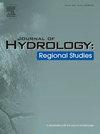Water resource vulnerabilities from climate-induced tipping point behaviour in runoff volumes and seasonality in the region of the ‘Karakoram Anomaly’: A snow-glacier melt perspective
IF 4.7
2区 地球科学
Q1 WATER RESOURCES
引用次数: 0
Abstract
Study region
Hunza River Basin, Karakoram range, Pakistan
Focus of study
Assessing the future persistence of the 'Karakoram Anomaly,' under climate change scenarios, where glaciers in the region exhibit stable or slightly negative mass balances, contrary to global trends.
New Hydrological insights for the region
The study explores how long the anomalous behaviour in Karakoram glaciers will persist under future climate scenarios. The results indicate a significant temperature rise under Shared Socioeconomic Pathway 5 (SSP5), whereas SSP2 exhibits greater variability. Snow Water Equivalent (SWE) is projected to decline due to reduced snowfall and faster snowmelt across all seasons, particularly in summer and autumn. Our glacio-hydrological model projects substantial glacier retreat from 4270 km2 in 2010 reducing to 3540 km2 or 2730 km2 by 2100 according to SSP2 and SSP5, respectively. Increased annual runoff peaks around 2050 (SSP2) and by 2070 (SSP5) before decline in total runoff by 2100. The study also highlights significant climate change impacts on seasonal hydrology, associated with declines in glacier and snowpack water storage in the next three decades. This stresses the need for adaptive water resource management (e.g. storage infrastructure or changing demand management) to address potential water shortages to human water users e.g. irrigation and hydropower and associated ecosystem disruptions including extreme flooding. These findings provide valuable insights for future hydro-climatic dynamics and policymaking in the region.
求助全文
约1分钟内获得全文
求助全文
来源期刊

Journal of Hydrology-Regional Studies
Earth and Planetary Sciences-Earth and Planetary Sciences (miscellaneous)
CiteScore
6.70
自引率
8.50%
发文量
284
审稿时长
60 days
期刊介绍:
Journal of Hydrology: Regional Studies publishes original research papers enhancing the science of hydrology and aiming at region-specific problems, past and future conditions, analysis, review and solutions. The journal particularly welcomes research papers that deliver new insights into region-specific hydrological processes and responses to changing conditions, as well as contributions that incorporate interdisciplinarity and translational science.
 求助内容:
求助内容: 应助结果提醒方式:
应助结果提醒方式:


